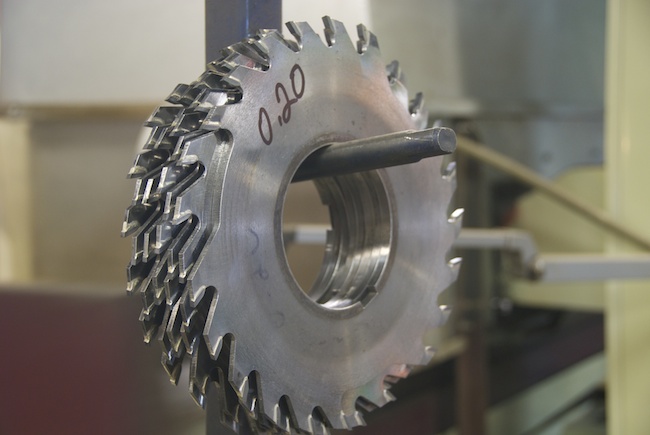
Features
Saw Filing 101: What’s driving your circular saws?
September 15, 2020 By Paul Smith
 Photo: Annex Business Media
Photo: Annex Business Media Collared, splined, or geared, your circular saws have to have a way to spin. This is a very important factor of how well your saws are running.
Collared circle saws
Collared circle saws are designed to be held on an arbor with collars. One inside collar and one outside collar hold the saw in between by bolting altogether as one. Of course, this is driven by a shaft that the collar is keyed, or attached to, in some way.
Although collared saws have been around as long as the modern saw, it seems we have lost some understanding of why they worked so well. And oftentimes, the collars are just not being machined or manufactured correctly. I have visited many mills that have installed new edgers running collared saws. On some new start-ups I have been asked to evaluate the machines because the saws would not cut a straight line, especially on edgers cutting four inches thick or more. Some manufactures have recently begun manufacturing flat collars as opposed to tapered so that the saw is held between the inside and outside collar, not leaving room for it to flex close and towards the arbor.
After many years of use, older collars can lose their taper due to wear. When the plate is held fast all the way to the arbor, the saw will not cut a straight line. The collar should have somewhere between 3/8 inches to 3/4 inches from the outside rim towards the center that will be tapered from .0003 to .0008, leaving enough room for the saw to flex. The amount of taper will be determined by the distance the saw is held from the outside edge of collar. Of course, less distance would mean less taper. By holding the saw on the very outside rim of the collar mirrored on both sides, the saw will stand up and run straight. Keep in mind that both collars should be exactly the same diameter and have the same distance from outside of the rim and the exact same taper. I have recently seen bad or worn collars that are causing trim saws to produce a bad end cut, causing splintered and uneven ends.
Spline circle saws
Spline circle saws are designed to be driven from an arbor that will either be made with the same designed spline that will drive the saw, or a splined sleeve that fits on the arbor doing the same thing. Spline saws are designed to float on the arbor with guides holding the saw in place, keeping it cutting on a sawline whether straight or curved. Many different splined saw combinations are available, and many manufacturers and saw filers have their own preference for which works better.
But no matter which spline design is used, they all require maintenance and upkeep. The splined arbor must be smooth and burr free to allow the spline saws to float correctly on the splined shaft. This splined arbor or sleeve will need to be moved periodically to keep this smooth. On some machines the saws can be shifted for the same reason. Anytime this is not kept up, the splines from the saw will eventually wear a groove in the arbor or sleeve causing the saws to hang and saw incorrectly. It is very important that the splines or gears on the arbor match up with the splines or gears on the saw itself, and should fit correctly. The saw should fit on the arbor loose enough to allow it to float well, but tight enough not to allow an excessive amount of backlash.
Feel free to call me about this or other saw issues. I enjoy talking saws.
 Paul Smith is the owner and CEO of Smith Sawmill Service LLC with locations in Texas and Louisiana. Reach him at paul@smithsawmillservice.com.
Paul Smith is the owner and CEO of Smith Sawmill Service LLC with locations in Texas and Louisiana. Reach him at paul@smithsawmillservice.com.
Print this page